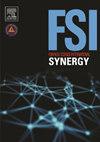Manner of death prediction: A machine learning approach to classify suicide and non-suicide using blood metabolomics
Q1 Social Sciences
引用次数: 0
Abstract
The classification of the manner of death (MOD) is a critical step in forensic investigations. The process is based on scene investigation, autopsy, histological and toxicological findings. However, in complex suicide cases, these findings may be insufficient to clearly establish the MOD and need potential biomarkers to assist judicial determinations. This study aims to identify specific biomarkers in the blood that could distinguish suicide from the non-suicidal deaths group. Heart blood samples were collected from suicide (n = 45) and non-suicide cases (n = 45) and metabolomic profiles were analyzed using proton nuclear magnetic resonance spectroscopy. Nineteen blood metabolites were significantly different between the groups (p < 0.05); especially, 4-hydroxyproline, sarcosine and heparan sulfate emerged as potential biomarkers for differentiating between the groups. A logistic regression-based predictive model incorporating sarcosine and heparan sulfate achieved sensitivity and specificity values of 73 % and 72 %, respectively. The integration of machine learning with blood metabolomics holds significant potential in forensic science and may apply to the model to adopt in criminal justice.

死亡预测方式:使用血液代谢组学对自杀和非自杀进行分类的机器学习方法
死亡方式的分类是法医调查的一个关键步骤。这一过程是基于现场调查、尸检、组织学和毒理学结果。然而,在复杂的自杀案件中,这些发现可能不足以明确确定MOD,需要潜在的生物标志物来协助司法决定。这项研究旨在确定血液中可以区分自杀和非自杀死亡组的特定生物标志物。分别采集自杀者(n = 45)和非自杀者(n = 45)的心脏血样,利用质子核磁共振波谱分析代谢组学特征。19种血液代谢物组间差异有统计学意义(p <;0.05);特别是,4-羟基脯氨酸、肌氨酸和硫酸肝素成为区分两组的潜在生物标志物。结合肌氨酸和硫酸肝素的基于逻辑回归的预测模型的敏感性和特异性分别为73%和72%。机器学习与血液代谢组学的结合在法医科学中具有巨大的潜力,并且可以应用于刑事司法中采用的模型。
本文章由计算机程序翻译,如有差异,请以英文原文为准。
求助全文
约1分钟内获得全文
求助全文
来源期刊

Forensic Science International: Synergy
Social Sciences-Law
CiteScore
4.90
自引率
0.00%
发文量
75
审稿时长
90 days
 求助内容:
求助内容: 应助结果提醒方式:
应助结果提醒方式:


